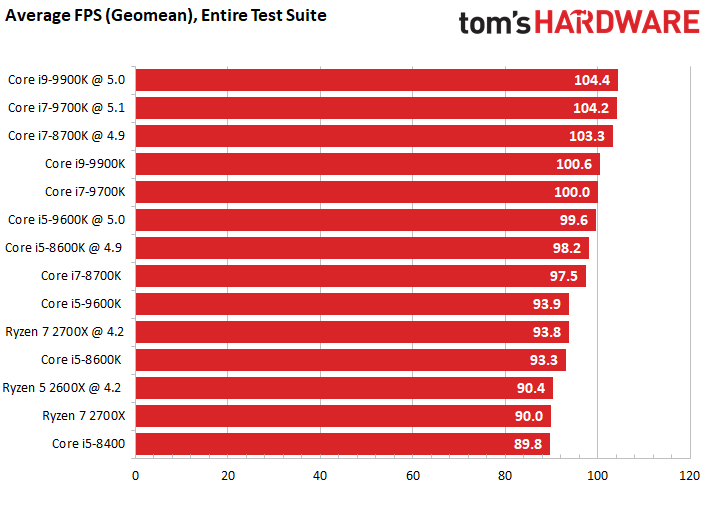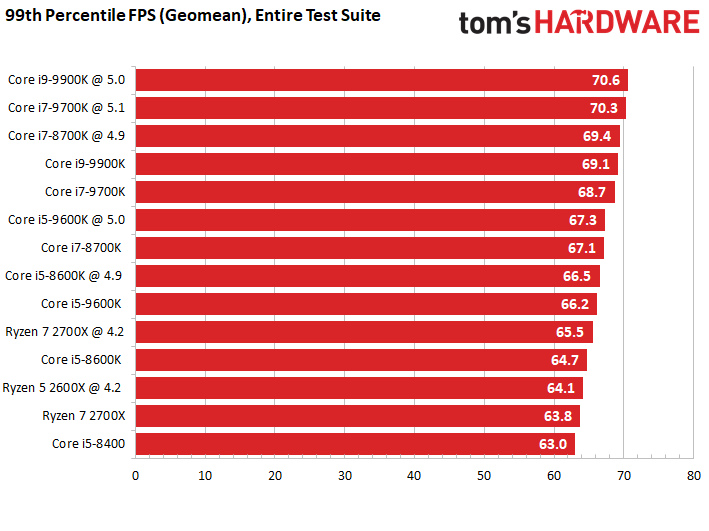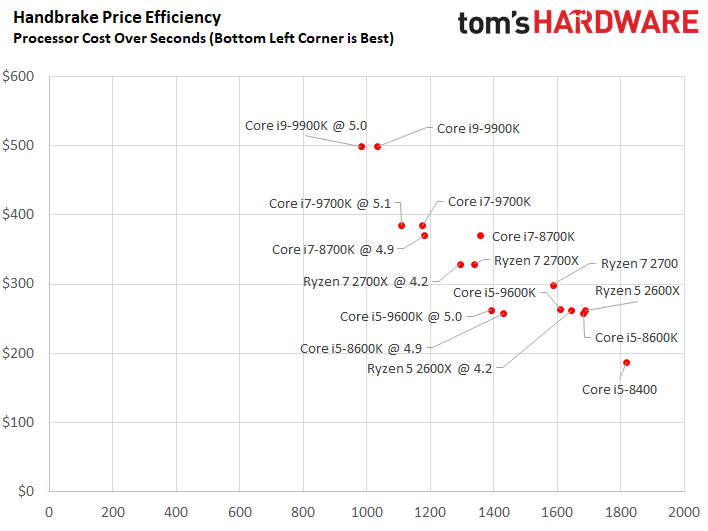Intel Core i5-9600K Review: A Mid-Range Gamer's CPU
Why you can trust Tom's Hardware
Conclusion
Intel’s ninth-gen Core i5-9600K is so similar to the eighth-gen Core i5-8600K that it does little to change the family’s competitive position against AMD's Ryzen line-up. Similar to the original Coffee Lake model, Core i5-9600K gives you six physical cores without Hyper-Threading technology, plus 9MB of L3 cache in a similar 95W package. The company does throw in slightly faster base and multi-core Turbo Boost frequencies, enabled through the use of solder-based thermal interface material to help with heat.
In the chart below, we plot gaming performance using average frame rates and a geometric mean of the 99th percentile frame times (a good indicator of smoothness), which we then convert into a frame-per-second measurement. Bear in mind that we tested with a Nvidia GeForce GTX 1080 at 1920 x 1080 to alleviate graphics-imposed bottlenecks. Differences between our test subjects shrink at higher resolutions.










The Core i5-9600K is the fastest gaming chip in its price range. But the performance advantage you get over an overclocked Ryzen 7 2700 or Ryzen 5 2600X might not justify spending extra money or sacrificing performance in other tasks. We know from experience that Intel's Core processors dominate when it comes to Web browsing, gaming, and office apps. But the Core i5-9600K isn't as competitive in heavily-threaded benchmarks like ones that involve rendering.
AMD's $299 Ryzen 7 2700 comes with a bundled cooler. That gives it a leg up on the ~$270 Core i5-9600K, which doesn't include a thermal solution. In both cases, you'll want something beefy sitting on top of the heat spreader for a shot at an aggressive overclock. You also get eight cores and 16 threads from the Ryzen. But it really needs tuning in order to keep up. Taking a small step down, the $225 Ryzen 5 2600X costs less than the Core i5-9600K and, again, comes with a heat sink/fan. However, you lose some performance in lightly-threaded tasks in exchange for a lower price tag.
Intel's ninth-gen Core CPUs add the benefit of solder-based thermal interface material. Aside from enabling higher multi-core Turbo Boost bins, the improved heat transfer didn't seem to do much for our tuning efforts. Maybe our sample is simply sub-par. But we think it's more plausible that Intel already squeezed most of the headroom out of this chip and its 14nm process. Fortunately, even a modest air cooler is fine for stock operation. The Core i5-9600K's relatively tame power draw is a good fit for mainstream motherboards. Just remember that you need a Z-series platform in order to overclock.
Choosing between a Core i5-9600K and Ryzen presents the same conundrum we've faced in the past: it depends on the type of software you run most frequently. If you're a gamer who doesn't really venture beyond 1920x1080, Intel's Core i5-9600K is the chip for you. But if a majority of your workloads are threaded in nature, including content creation and productivity, a powerful Ryzen gets you more performance at a competitive price.
MORE: Best CPUs
Get Tom's Hardware's best news and in-depth reviews, straight to your inbox.
MORE: Intel & AMD Processor Hierarchy
MORE: All CPUs Content

Paul Alcorn is the Editor-in-Chief for Tom's Hardware US. He also writes news and reviews on CPUs, storage, and enterprise hardware.
-
Tobias Claren How high can I overclock with intel boxed cooler?Reply
Or a cooler that fits in a mini itx case lake Silverstone Raven or similar (12 litres or less)?